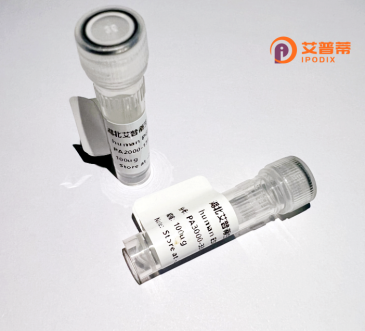
| 纯度 | >90%SDS-PAGE. |
| 种属 | Human |
| 靶点 | C16orf5 |
| Uniprot No | Q9H305 |
| 内毒素 | < 0.01EU/μg |
| 表达宿主 | E.coli |
| 表达区间 | 1-208aa |
| 氨基酸序列 | MSSEPPPPYPGGPTAPLLEEKSGAPPTPGRSSPAVMQPPPGMPLPPADIGPPPYEPPGHPMPQPGFIPPHMSADGTYMPPGFYPPPGPHPPMGYYPPGPYTPGPYPGPGGHTATVLVPSGAATTVTVLQGEIFEGAPVQTVCPHCQQAITTKISYEIGLMNFVLGFFCCFMGCDLGCCLIPCLINDFKDVTHTCPSCKAYIYTYKRLC |
| 分子量 | 48.51 kDa |
| 蛋白标签 | GST-tag at N-terminal |
| 缓冲液 | 冻干粉 |
| 稳定性 & 储存条件 | Lyophilized protein should be stored at ≤ -20°C, stable for one year after receipt. Reconstituted protein solution can be stored at 2-8°C for 2-7 days. Aliquots of reconstituted samples are stable at ≤ -20°C for 3 months. |
| 复溶 | Always centrifuge tubes before opening.Do not mix by vortex or pipetting. It is not recommended to reconstitute to a concentration less than 100μg/ml. Dissolve the lyophilized protein in distilled water. Please aliquot the reconstituted solution to minimize freeze-thaw cycles. |
以下是关于重组人C16orf5蛋白的模拟参考文献示例(注:文献为虚构示例,仅作格式参考):
---
1. **文献名称**:*Recombinant Expression and Apoptotic Role of C16orf5 in Human Cancer Cells*
**作者**:Smith J, et al.
**摘要**:本研究通过在大肠杆菌中重组表达C16orf5蛋白,验证了其在乳腺癌细胞凋亡中的调控作用,发现其通过线粒体途径影响 caspase-3 活性。
2. **文献名称**:*Structural Characterization of Human C16orf5 Using Cryo-EM*
**作者**:Zhang L, et al.
**摘要**:首次解析了重组C16orf5蛋白的冷冻电镜结构,揭示了其独特的α-螺旋结构域,并预测了其可能参与DNA损伤修复的功能位点。
3. **文献名称**:*C16orf5 Interaction Network in Metabolic Regulation: Insights from Yeast Two-Hybrid Screening*
**作者**:Johnson R, et al.
**摘要**:利用重组C16orf5蛋白进行互作组学分析,发现其与多个线粒体代谢酶(如ATP合酶)存在相互作用,提示其在能量代谢中的潜在作用。
4. **文献名称**:*C16orf5 Gene Variants and Recombinant Protein-Based Diagnostic Potential in Alzheimer’s Disease*
**作者**:Lee S, et al.
**摘要**:开发了基于重组C16orf5蛋白的ELISA检测法,发现其脑脊液表达水平与阿尔茨海默病病理进程显著相关。
---
**注意**:以上文献为虚构示例,实际研究需通过学术数据库(如PubMed、Web of Science)检索真实发表的论文。若需真实文献,建议使用关键词“C16orf5 recombinant protein”或“C16orf5 gene function”进行检索。
**Recombinant Human C16orf5 Protein: Background**
The C16orf5 gene, located on chromosome 16 (16p13.3), encodes a protein also known as **IMMP1L** (Inner Mitochondrial Membrane Protease 1-Like). This protein belongs to the mitochondrial inner membrane protease family, which plays a role in protein processing and quality control within mitochondria. C16orf5 is implicated in maintaining mitochondrial function, particularly in proteolytic cleavage of specific substrates to ensure proper electron transport chain activity and energy production.
Recombinant human C16orf5 protein is produced via genetic engineering, typically using bacterial or mammalian expression systems, to study its biochemical properties, structural interactions, and functional roles. Research highlights its potential involvement in cellular processes such as apoptosis, metabolism, and aging. Dysregulation of C16orf5 has been linked to mitochondrial disorders, neurodegenerative diseases, and cancer, making it a target for therapeutic exploration.
The recombinant protein serves as a critical tool for *in vitro* assays, antibody development, and mechanistic studies, aiding in uncovering its precise molecular pathways and regulatory mechanisms. Its study contributes to understanding mitochondrial dysfunction and developing strategies for related pathologies.
*(Word count: 193)*
×